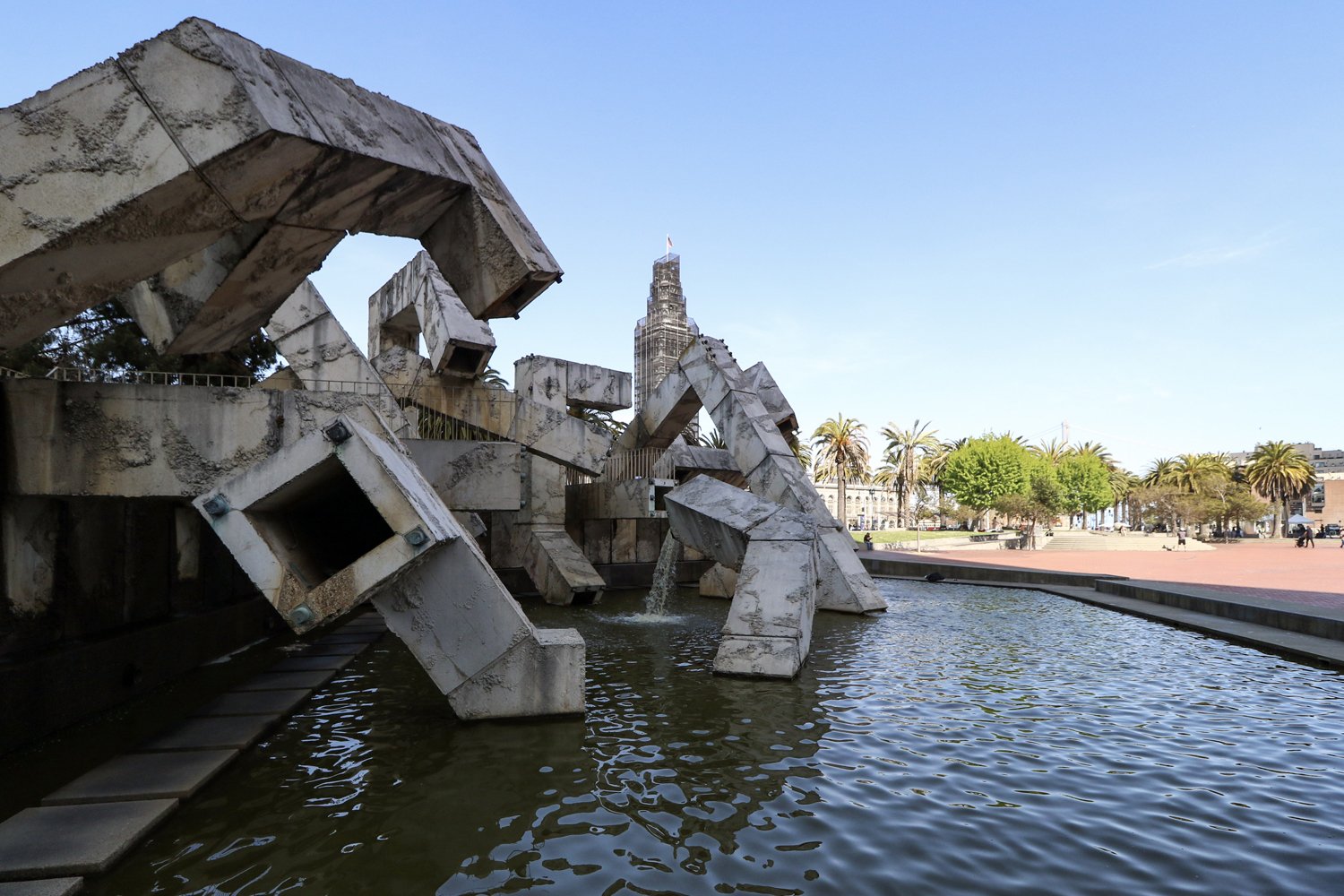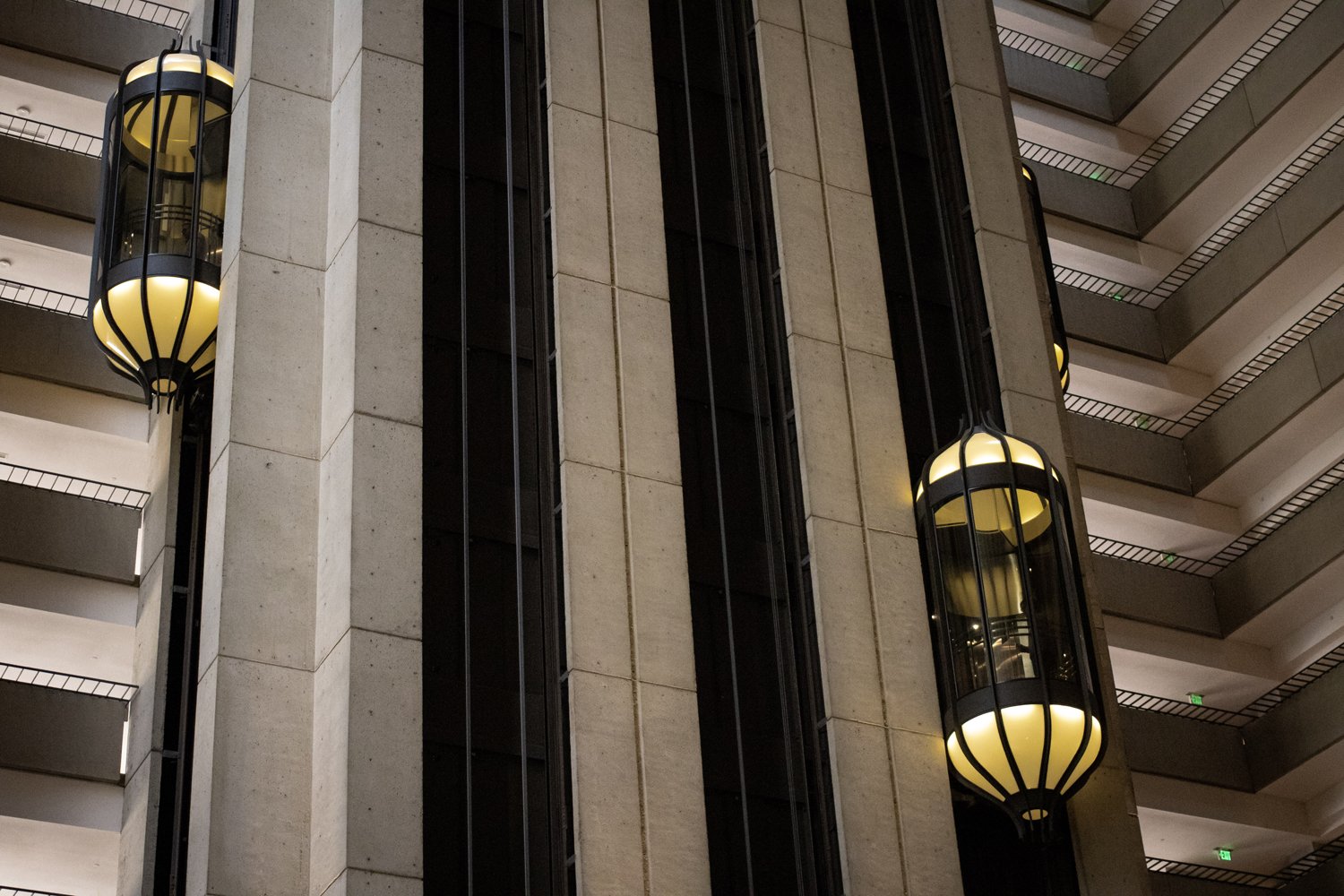Vaillancourt Libre
San Francisco’s Hyatt Regency and Vaillancourt Fountain near the Embarcadero as photographed in May 2023.
I’m not an architectural critic by any means, but the San Francisco Chronicle’s John King is. In 2016, the two-time Pulitzer Prize finalist described the city’s iconic Hyatt Regency building as a “sci-fi hotel” that had gone from “daring to dated.” He most certainly had a point, but I personally adore the building, as well as, its complementary piece of aquatic, public art. The hulking hotel near the waterfront initially opened to high praise in 1973. Situated between San Francisco’s waterfront and its Financial District—the building remains as an upscale, 4-star lodging establishment who’s design has become a symbol of the city. While in the area recently, it was one of the sights I specifically sought out.
Separated from the surrounding streetscape in a manner that King described as a “temple of hermetic urbanism,” it took us a good while to find the entrance. Inside, the cavernous area is something to behold—an inverted canyon that’s considered the largest hotel lobby in existence per the Guinness Book of World Records.
Eclipse (1973) by Charles O. Perry (1929-2011).
The centerpiece of the interior is an artwork known as Eclipse (1973), which was commissioned specifically for the hotel from acclaimed sculptor Charles O. Perry (1929-2011). The 40-foot tall piece is visually stunning, but in my opinion: the best piece of art can be found out front where the California sun dramatically strikes against the hotel’s angles.
Vaillancourt Fountain occupies an outdoor plaza near the Hyatt Regency.
I had no idea that the Vaillancourt Fountain even existed, finding myself drawn to it while searching for the Hyatt Regency’s entrance. Like I said, I’m not an architectural critic and for that matter: I’m not an art critic either (although I did spend plenty of time in college art classes). Still, the fountain immediately captured my attention with the way it stood among its surroundings. The whole thing was like a scene out of the 1990s cartoon version of the Teenage Mutant Ninja Turtles come to life. Something akin to a brutalist interpretation of a waterpark. One where the H2O had hues of green and yellow, certain features didn’t work, and debris had been blowing into the pool—accumulating in floating piles of chip bags, plastic soda bottles, and algae. It smelled chlorinated and comforting, though, like a fountain you’d find inside a mall back when malls were a thing.
Walking the stepping stones underneath or climbing the fountain’s stairs didn’t seem like activities that were technically allowed, but no one was around to tell us otherwise. In fact, no one was really around at all. The fountain simply roared and splashed in this liminal space between the aforementioned hotel and the city’s principal tourist area. I loved it.
Once described by the New York Times as a “Stonehenge unhinged with plumbing troubles,” Vaillancourt Fountain is also unofficially known as “Quebec Libre.” Right before it was opened in 1971, someone spray painted the phrase “Quebec Libre” onto the structure in reference to the Canadian province’s sovereignty movement. Although the graffiti was removed by the city, the fountain’s namesake designer—Quebecois sculptor Armand Vaillancourt—also spray painted the phrase onto the fountain as many times as he could during the dedication. The act was his homage to the original “vandalism,” something he interpreted as a meaningful gesture of free speech.
Graffiti intersected with the fountain once more in 1987 when U2 played a free concert in the adjoining plaza. During the closing song, frontman Bono climbed the structure and spray painted the phrase “Rock N Roll Stops the Traffic” on it. Then-Mayor, now long serving California Senator Dianne Feinstein, was apparently none too pleased about this, but Vaillancourt praised Bono. 36 years later: Feinstein is still in politics, U2 is still touring, Quebec is still part of Canada, and Vaillancourt is still defending his namesake fountain.
Ever since its debut, the fountain has received mixed reactions from both the art world and the public. Proposals to demolish it have been around since 1989 and at several points in history, the flow of water has been shut off for both conservation and maintenance reasons. For now, though, the water feature’s continued existence seems to be secure, and it was mostly working when I saw it in the Spring of 2023. I hope it sticks around for a long time to come. “Vaillancourt Libre!”
The nearby hotel also has its fair share of design criticisms, but unlike the fountain, it seems to still be perceived as a beloved landmark. With 20 floors featuring 804 rooms, it remains a popular destination within steps of the city’s famed cable cars and streetcars.
A streetcar passes by the Hyatt Regency on Market St. Out of view behind it is a boarding point for the city’s iconic cable cars. The rooftop restaurant (which no longer revolves) can be seen at the building’s peak.
The former revolving restaurant at its peak no longer spins, but the space remains a swanky night club even if the motion novelty is gone. The place has also made several appearances in popular media, serving as a filming location for movies such as The Towering Inferno (1974) and Mel Brooks’ High Anxiety (1977).
The building’s iconic elevators.
The Hyatt Regency’s iconic elevators as seen in Mel Brooks’ High Anxiety. The hotel’s lobby was also featured in The Towering Inferno.
In his 2016 article, the Chronicle’s John King had summed up the Hyatt Regency as “a futuristic vision” that’s “now a relic of the past.” Much like the similarly* styled Contemporary Resort of Walt Disney World in Orlando—the aesthetics, designs, and ideals of the future that these building’s portrayed didn’t really pan out. Yet, they remain as important, historical reminders of the optimism felt by creatives and thought leaders of their time. Folks such as John Portman, who’s Hyatt Regency still commands a space on the San Francisco skyline today.
35mm
* To be clear: I say “similarly,” because they look similar to me, hail from similar eras, use similar materials, and seem to represent similar ideals. I don’t claim to know if they’re the same, technical “architectural” style. Again, not a critic, just a dude who likes cool buildings and weird fountains.
Since 2007, the content of this website (and its former life as Queen City Discovery) has been a huge labor of love.
If you’ve enjoyed stories like The Ghost Ship, abandoned amusement parks, the Cincinnati Subway, Fading Ads, or others over the years—might you consider showing some support for future projects?














